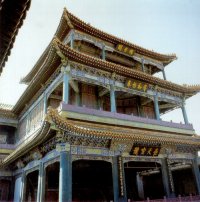![]()
![]()
Pavilion of Pleasant Sounds

Figure 8.1: Pavilion of Pleasant Sounds
Click on the image to enlarge it
Architecture Information
It is a
three-storied building built in the Palace of Peaceful Old Age during the reign
of Qian Long in the Ching Dynasty (Dorn 223).
The first floor is called the Stage of Longevity (as shown in figure 8.2);
the second floor is called the Stage of Good Fortune (as shown in figure 8.3),
and the third floor is called the Stage of Happiness (as shown in figure 8.4).
The Stages are small and shallow on the second and third floors.
They were designed based on the building, Yue Shi Lou, where the emperor
sat and watched the opera (Ru 130).
Detail
In the
Ching Dynasty, the major entertainment for the imperial family members in the
Forbidden City was going to the theater (Yu 165).
Chinese operas were a combination of the dramatic arts, history, and
legend (Dorn 224). It is also
significant to the Ching Dynasty�s religion.
For example, during the play of �The Imperial Birthday� was
performed, actors wore the �costumes of Taoist immortals and Buddhist
characters� to celebrate the emperor�s birthday (Yu 162).
There were also performances during some special occasions in the
Pavilion of Pleasant Sounds. These
festive occasions were the Beginning of Spring, the fifteenth day of the first
month, the nineteenth day of the first month, the Dragon Boat Festival, the
Cowherd and Weaver Maid Evening, the Mid-Autumn Festival, the Double Nine
Festival, the Winter Solstice, and Winter Sacrifice, New Year�s Eve, birthdays
of the emperor or empress, accession to throne, appointments of important
officials, and granting of titles and territories (Yu 165).
![]()
Home Background Map Religion Libraries Theaters Conclusion Bibliography
Created by May Wong